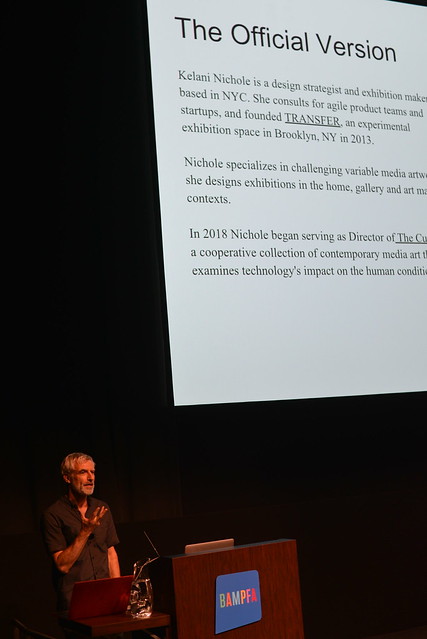ATC Revisited: Kelani Nichole

Recap by KC Forcier, the 2018-2019 Graduate Liaison for the Art, Technology, and Culture Colloquium
The Networked Avant-Garde: Curator Kelani Nichole on Exhibiting Art in the Digital Age
As a technologist and a curator, Kelani Nichole is uniquely attuned to the opportunities and challenges presented by digital contemporary art. Through her work as the founder of TRANSFER Gallery in Brooklyn, exclusively dedicated to presenting digital art, Nichole has championed a generation of artists she terms the “Networked Avant-Garde.” The networked avant-garde are those artists commenting on and employing networked, digital culture. These artists work in a wide variety of digital media including animated GIFs, AR/VR, and moving images (the only technical stipulation to be a TRANSFER artists is that the work must fit on a hard drive). As products of network culture, this work is frequently openly available online, made from reappropriated or crowdsourced web content, or created in collaboration via the network. As with much digital content, these works are often iterative, developing and changing over time.
Given these characteristics, the work of the “networked avant-garde” doesn’t fit easily into the institutional structures of the traditional art world. Digital art presents technical challenges for the gallery: works that are made with personal computers and cell phones, crafted from the digital culture of the internet must be consciously adapted for the public viewing of the gallery. According to Nichole, “Today artists live, work and exhibit on the Internet…. their resulting body of work is sometimes best suited for the browser – at TRANSFER the work develops beyond the screen into the physical space of the gallery.” Nichole’s efforts to support digital art’s move from the web browser to the gallery includes the TRANSFER Download, a three-channel projection system for translating a wide variety of media formats into a systematic and portable public display. Another example of Nichole’s innovations for exhibiting digital art has been her collaborations with VR artists to develop systems for opening up their work for collective viewing.
Aside from these technical challenges, the diffuse and diverse nature of networked art has also meant that it has been assimilated into the existing art market with some difficulty. An important part of TRANSFER’s mission is to facilitate digital art’s acceptance in the commercial art world, opening up avenues and models for the collection of digital work. TRANSFER promotes the collection of digital art by raising the art-world visibility of these artists, while developing standardized practices and language for the work. Nichole has coined the term “Simulism” to refer to this digital, networked turn in contemporary art. The term encapsulates digital art’s emphasis on simulation, process, systems, and reappropriation, but more importantly for Nichole, it helps conceptualize an exceedingly diffuse, diverse, and constantly mutating body of work into a graspable movement, on the level of pervious “isms” in art.
These efforts to champion a new wave of art are undoubtedly important - they bolster and gain visibility for avant-garde artists while making it easier for them to receive compensation for their work - however, several of the audience questions on Monday night raised the issue of whether integrating networked art into the commercial art world in some ways undermines vital aspects of this work. As process or performance-based art before it, the immateriality and iterability of the networked avant-garde constitute a powerful critique of the institutions of the art world. Their precarity, immateriality and iterability resist the commodification of art. Much of the digital art of this generation of artists uses the stuff of advanced capitalism - affect, knowledge, performance, the immaterial - to critique the power structures which sustain it. Nevertheless, the existence of this tension - between the institutions of commercial art and digital art’s critique of these institutions - is itself productive, and demonstrates the need for artists, curators, and scholars to together continually examine the role of digital technologies in the shifting terrain of art today.

